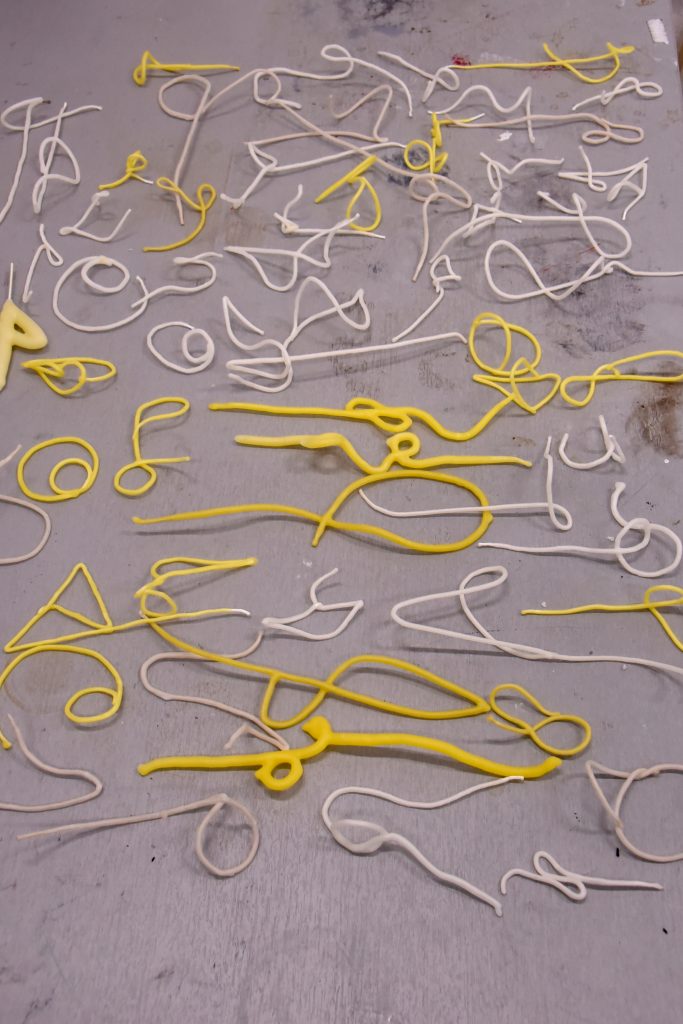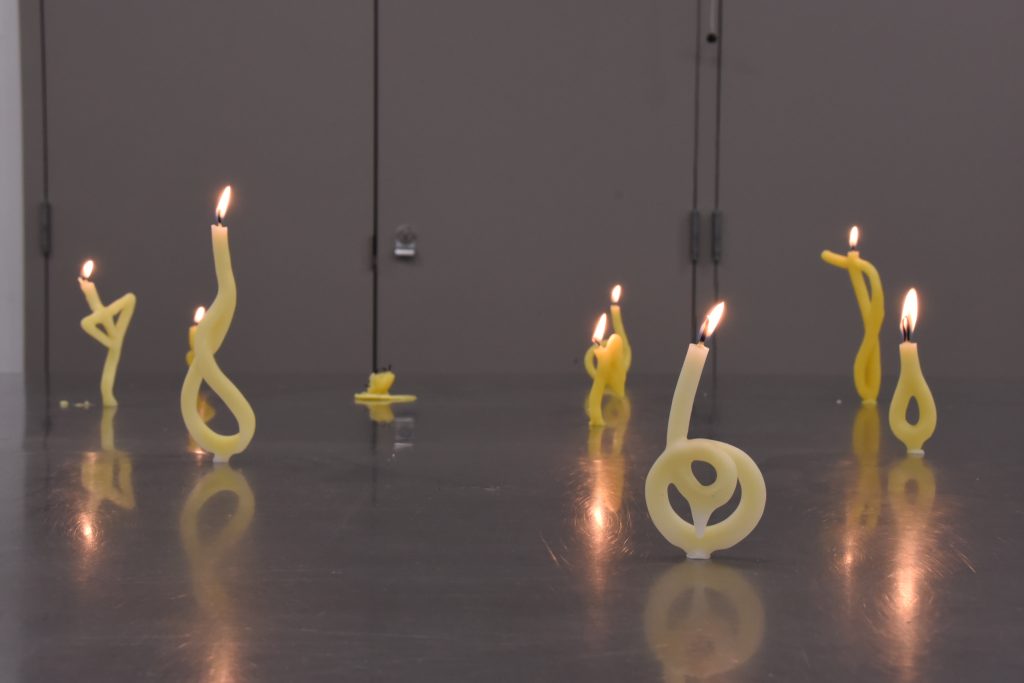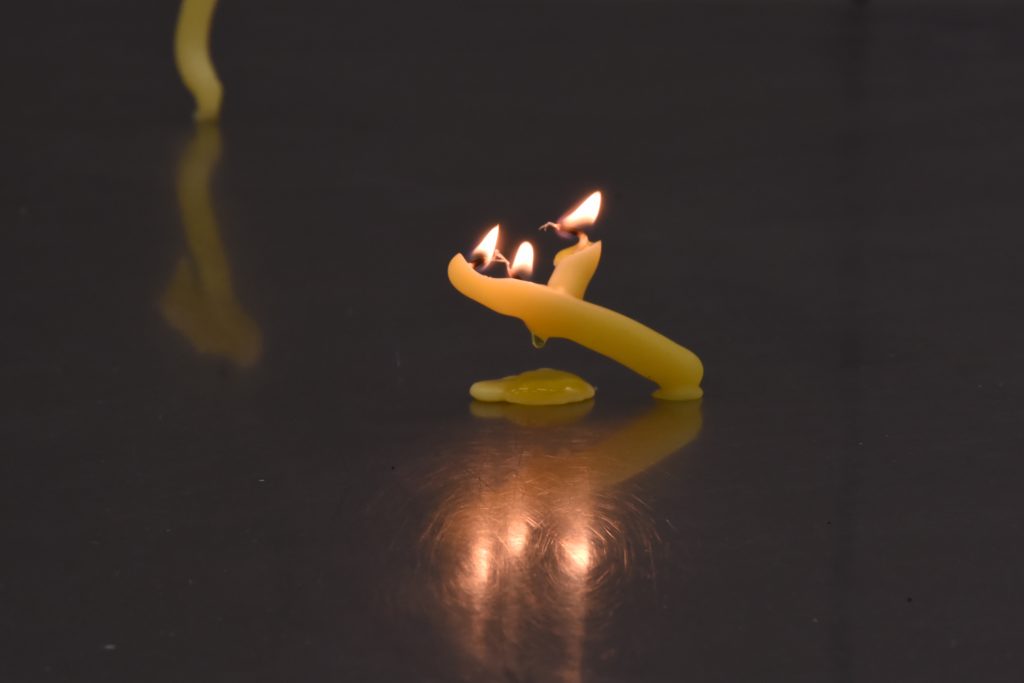What does it mean when we observe speed or altitude changing the pace of time? How can different outcomes in time both exist in a “superposition”, or even more bafflingly, cause reality to split off into different worlds? Beyond the artificial, oversimplified construct of hours and minutes, the nature of time, which resides in all living and non-living things, is incredibly difficult to understand. For this reason, I have been drawing.
I use thin cotton cords coated with wax to draw. The balance of flexibility and structure lets me draw the line in almost any direction in space. When I’m satisfied with the drawings, I coat it in layer upon layer of wax until it becomes a candle. Neither the wax nor the wick is truly my drawing medium though. The only basic law of physics that distinguishes the past from the future is: if nothing else around it changes, heat cannot pass from a cold body to a hot one. What I am drawing with is the arrow of time – heat and the potentiality for heat.

In Andy Goldsworthy’s Storm King Wall, he draws a line that extends from the highway into the river, then emerges from the water and winds through the woods with a stonewall. In Rivers and Tides, Goldsworthy says of this work, “A wall is the line that is in sympathy with the place through which it travels, and that sense of movement is very important to understanding the sculpture. All the movement and passage of people, the movement of the wall, of the stones as they run around the trees, the river of growth that is the forest. And it has made me aware of that flow around the world, the veins around the world.”
Like Goldsworthy, my drawings help me to see what surrounds us but is perhaps invisible to the everyday glance. I am not worried about the exact shape of the lines I draw, because if time is both relative to where we are and constantly splitting into different worlds, then it stands to reason that it exists in every shape, whether we are aware of them or not. I meditate on a memory of mine – important but faded, embedded underneath time – as I draw. I find that the lines I make nearer to the memory are more circular and enclosed, multiple loops leading to the same direction; those that are further away from the memory are more open, gentle bends leading to wildly shifting directions.
In Tim Ingold’s book, he writes about John Ruskin’s leading lines :
“.. lines that embody in their very formation the past history, present action and future potential of a thing. The lines of the mountain show how it has been built up and worn away, those of the tree show how it has contended with the trials of life in the forest and with the winds that have tormented it…”
The lines that I’m finding with candles wicks attempt to show not the history, present and future of a mountain or tree, but that of a memory. From the temporal location of the memory, I turn around and notice that the numerous lines of possibilities in the distance have become much fewer and more enclosed, as I get close to the moment that has already transpired.
When I install my candle drawings on the walls, they cast shadows that look like letters of a language. In Ingold’s text, he asks, at what stage does a child cease to draw letters and begin instead to write? Referencing the work of Russian psychologist Lev Vygotsky, Ingold quotes:
“There is a critical moment, however, at which the child discovers that the mark he has made on paper is a depiction of something, and moreover that this thing bears a name. Thenceforth the naming of the object can precede rather than follow the act of drawing it… But he is still not writing it. Writing calls for one further shift, prompted by the discovery that letters can be arranged in meaningful combinations to form words… Only when he can read can he also be truly said to write.”
Like the child who first draws and then discovers the name of what he has made, I have to first draw before I recognise in them the lines of tree rings, water ripples, gnarly branches, before I discover in them the movement of time. In Ingold’s terms, my candle drawings and the shadows that they cast are notations – notations with multiple but certainly not arbitrary meanings and associations. Despite the visual similarities to calligraphic strokes or alphabets, perhaps my drawings cannot become writings because I cannot read them with certainty.
But by Vygotsky’s definition, I also refuse to let my drawings become writing. In the West, alphabets are used as a tools for communicating ideas in written form. Therefore, it is not possible to write what we do not yet know. Towards the end of the Rivers and Tides, Goldsworthy expresses that it is often difficult for him to talk about his work because his drawings, made from natural materials, create for him a world beyond what words can define. But Goldsworthy’s recurring lines in nature already form a language. I want to propose that we can write what we do not yet know by letting our drawings discover their own layers of notation.

